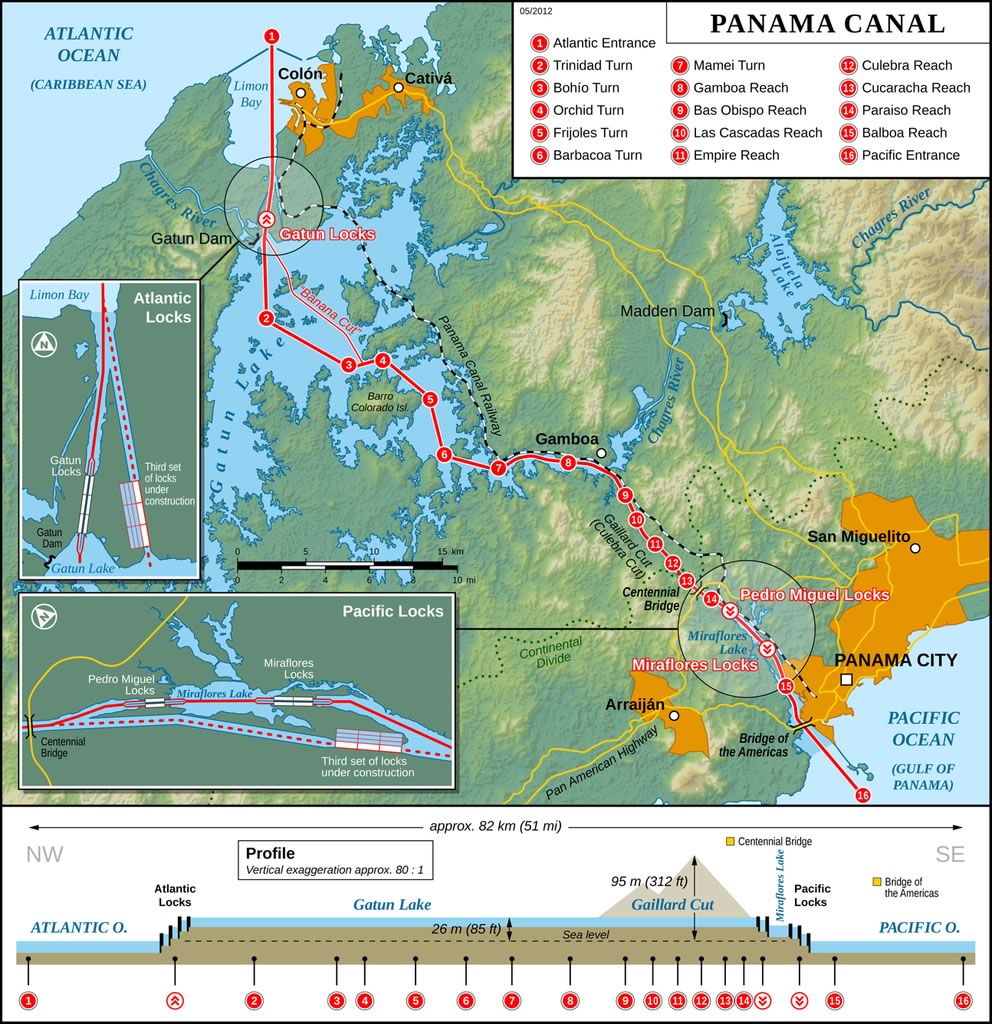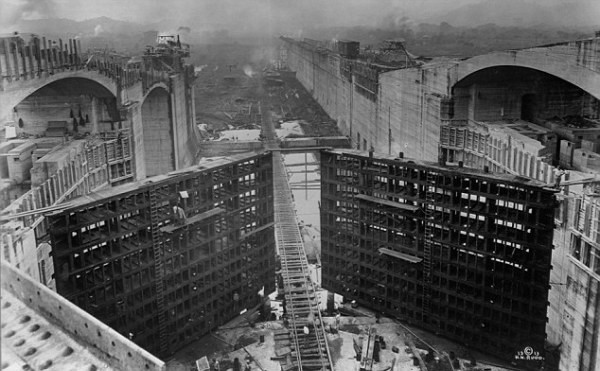 |
| Panama Canal |
Ever since the Spaniard Vasco Núñez de Balboa's "discovery" of the Pacific Ocean in 1513, Europeans had dreamed of an oceanic shortcut linking the Atlantic to the Pacific. The Panama Canal, built by the U.S. government from 1903 to 1914, realized that vision at the cost of $352 million and, by official count, 5,609 lives from accidents and disease (including some 4,500 black West Indian laborers). The canal, which extends from Colón on the Caribbean side to Panama City on the Pacific, traverses 77 kilometers through three sets of locks.
One of the most remarkable technological feats in world history and far and away the largest engineering project ever undertaken up to that time, the Panama Canal transformed markets, demographics, geopolitics, and national histories in the Western Hemisphere in myriad ways. After 1902, protection of exclusive U.S. rights to a transisthmian canal was the pivot upon which U.S. policy in the Caribbean and Central America turned.
The many episodes of U.S. military, political, and economic intervention in the first three decades of the 20th century can be traced, directly or indirectly, to larger U.S. economic and geostrategic interests centered on the Panama Canal.
  |
For many years, the Panama route had been considered impractical due to the elevation of the continental divide. That the canal ended up being built in Panama and not in Nicaragua resulted from a highly unlikely combination of circumstances, including a bloody three-year civil war in Colombia and its province of Panama (1899–1902); the 1901 assassination of President William McKinley; the imperialist inclinations of McKinley's vice president and successor, Theodore Roosevelt; and an intensive last-minute campaign by the "Panama lobby" in the halls of the U.S. Congress.
The building of the canal in Panama capped more than half a century of various schemes for an interoceanic route that intensified with the U.S. victory in the Mexican-American War (1846–48) and the California gold rush of 1848–49.
In 1850 the U.S. and British governments signed the Clayton-Bulwer Treaty, in which both countries agreed (without consulting Nicaragua) that neither would exercise exclusive rights to the proposed Nicaragua canal.
The 1850s saw two land routes built across Central America: the Panama Railroad (completed in 1855) and the Nicaragua route, brainchild of Cornelius Vanderbilt and his Accessory Transit Company (in service from 1851 to 1856).
 |
| Panama Canal construction |
Serious surveying work for a transisthmian canal route began in the 1870s by two different groups: a French syndicate and the U.S. government. In 1878 the Colombian government granted canal rights to a French consortium under the direction of Ferdinand de Lesseps.
Construction commenced in 1881, but by 1889 disease, cost overruns, and related problems led to the firm's bankruptcy and the project's abandonment. As many as 20,000 workers died during the eight-year fiasco.
In 1901 a U.S. commission unanimously recommended the Nicaragua route. In that same year the U.S. and British governments signed the Hay-Pauncefote Treaty, abrogating the 1850 Clayton-Bulwer Treaty and granting the United States exclusive rights to the proposed Nicaragua canal.
   |
The 1902 U.S. decision to build the canal in Panama shocked and dismayed the Nicaraguan elite, who had been convinced that the canal would be built in their country. In January 1903 U.S. and Colombian negotiators signed the Hay-Herrán Treaty, granting the U.S. government a strip of land across Panama for the proposed canal in exchange for $10 million and $250,000 per year thereafter.
The Colombian senate rejected the treaty. President Roosevelt, infuriated by those he termed the "contemptible little creatures ... the Bogotá lot of jackrabbits," engineered a rebellion by dissident elements in Panama. The rebels declared independence on November 3, 1903.
Three days later the Roosevelt administration recognized the breakaway republic. On November 17 the two nations signed the Hay-Bunau-Varilla Treaty, granting the United States exclusive and perpetual control of the canal zone under the same terms as the scuttled Hay-Herrán Treaty with Colombia. As Roosevelt later declared, "I took the Canal Zone."
Actual construction commenced in 1907, and the canal opened on August 15, 1914. In 1921 the U.S. government agreed to pay Colombia $25 million in exchange for Colombian recognition of Panama's independence.
In September 1977 U.S. president Jimmy Carter and Panama chief of government Omar Torrijos signed the Panama Canal Treaty, relinquishing U.S. control of the canal to Panama by the year 2000. Panama assumed formal control of the canal at noon on December 31, 1999. The technical, diplomatic, and geopolitical aspects of the Panama Canal have spawned a vast literature.